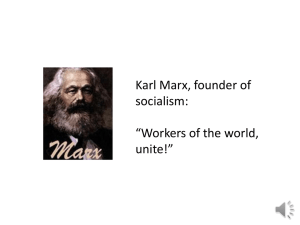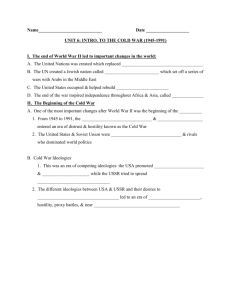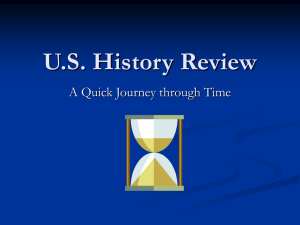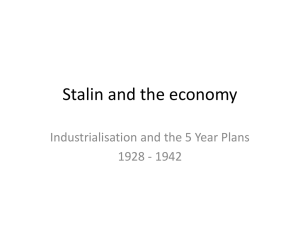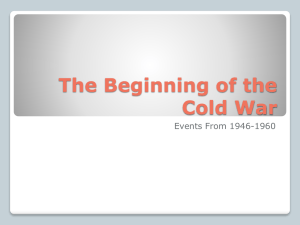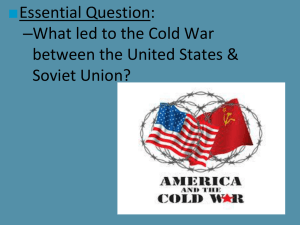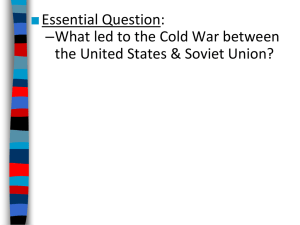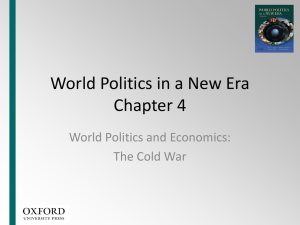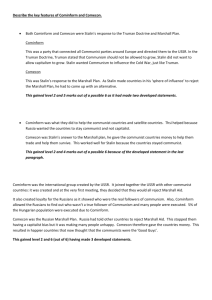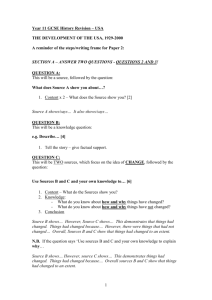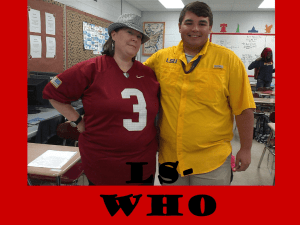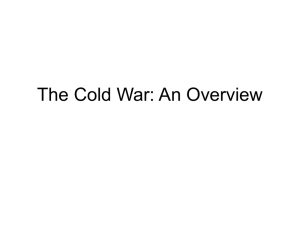7- Communism
advertisement
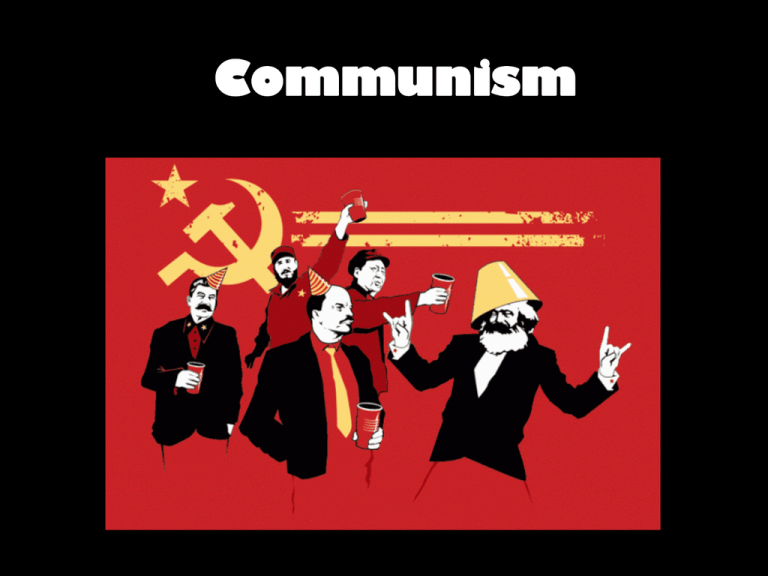
Soviet Union and Satellite Nations Timeline of Communism in the 20th Century Communism in the USSR (1917 – 1989) Communism in China (1949 – present) 1910 1920 Communist Revolution in Russia (1917) 1930 1940 1950 Communist Revolution in China (1949) 1950: Korean War “Cold War” 1960 1970 Vietnam War 1966: China’s “Cultural Revolution” 1980 1990 1989: Fall of Communism in the USSR 1989: Tiananmen Square in China Origins of Communism • Karl Marx: Father of Communism wrote Communist Manifesto • Asked workers (proletariat) of the world to revolt and take control of the “means of production” Communism • Socialism: a type of economic system in which gov’t runs the economy for the entire society • Communism: socialism with totalitarian dictatorship • Marxism: communism with violent radical revolution – CLASS STRUGGLE Communism comes to Russia • • • • Life under the Czar: Too many poor peasants Not enough land or food Hate being involved in WW1 • Russia remained unindustrialized No supplies for the troops (not enough railroads or factories) • By 1915, many soldiers do not have weapons or ammunition Hello! I FEEL RIGHT AT HOME! MAMMA’S HAPPY! Group of nobles WELCOME TO MY CRIB ! Prince Felix Yusupov moika palace I’M FEELING OK ! I’M STILL FEELING OK ! BAM ! BAM ! BAM ! FUNNY… MY BACK IS ITCHY ! BAM ! POW ! BOOM ! SPLASH ! I DON’T FEEL SO HOT… HELP !!! ! HELP… I’M DROWNING ! I’LL BE BACK ! The Provisional Government • Czar Nicholas II abdicated (gave up the throne) • A moderate temporary gov’t was created The Bolsheviks • • • • Name of the Communist Party in Russia Began the Communist Revolution Led by Vladimir Lenin - RADICAL Offered the poor “Bread, land, and peace” 1917 Revolution • Bolsheviks overthrew provisional gov’t • Created new Communist nation USSR Russian Civil War • Red Army (communists) vs. White Army (supporters of Czar) • Red Army won! Killed millions Cheka (secret police) Assassination of Czar & family Lenin’s U.S.S.R. • The U.S.S.R. • Union of Soviet Socialist Republics – aka “Soviet Union” “The most striking thing was the utter unexpectedness of it, like a train crash in the night, like a bridge crumbling beneath your feet, like a house falling down” Bye! Russia lost: • Most of its land in Europe •32% of its farmland •34% of its population •54% of its industry 89% of its coalmines • The Russian banks were all nationalized. • Control of the factories was given to the soviets. • Private bank accounts were confiscated. • The Church's properties (including bank accounts) were seized. • Wages were fixed at higher rates than during the war and a shorter, eight-hour working day was introduced. Decree on Land Private Property Treatment of the Wealthy Princess Golitsyn sold homemade pies on the street Baroness Wrangel sold knitwear One baroness sold a diamond broach for 5,000 rubles (the cost of a bag of flour) = New Economic Policy • Lenin’s plan to help the economy • The gov’t would control only major businesses • People could control small businesses and earn profit (limited capitalism) Stalin’s U.S.S.R. • Joseph Stalin: Took over after Lenin’s death • Became a brutal dictator Totalitarian State: • Only one political party allowed → the Communist Party • Controlled all aspects of life • Put state concerns ahead of your own Collectivization • Stalin’s plan to improve farming • Eliminated small farms – they were “collected” onto large, state-run farms • If you refused, you DIED 5-Year Plan • Stalin’s plan to industrialize • Focused on heavy industry (military, steel, mining, farm machines) • Not on consumer goods (things for people’s lives) Purges • Stalin’s attempt to eliminate anyone that could threaten his control • Many government officials were imprisoned or executed Ex. Trotsky exiled and killed + = World War II • Stalin signed a nonaggression pact with Hitler • Germany attacked the USSR → the USSR joined the “Allies” The Cold War Yeah RIGHT I’ll help fight Japan and I’ll totally allow free elections in Eastern European countries soon. The Cold War Roots of the Cold War: • There was a war of ideas between two sides (U.S. and U.S.S.R.) • There was a great deal of mistrust after World War II • The way Europe was divided up after WW II caused an uneasy tension Cold War Terms: • Iron Curtain: name for the imaginary dividing line between the Democratic Western European nations and the Communist East European nations From Stettin in the Baltic to Trieste in the Adriatic an "iron curtain" has descended across the Continent. Cold War Terms: • Eastern Bloc: the group of nations – that were communist – in Eastern Europe (behind the “Iron Curtain”) • “satellites”: Another name for the “Eastern Bloc” nations • Countries that were “controlled” by and near the USSR The 2 Sides Alliance Leading Nation Foreign Policy Economic System Type of Government Command Economy • “Central Planning” • State-control of production, quotas, distribution All economic decisions made by gov’t • NO private business only GOV’T ownership Containment Events of the Cold War • Marshall Plan / Truman Doctrine: • U.S. offered billions of $ to help rebuild European nations after WW2 as long as they were NOT communist Berlin Airlift You can go, But I’m not leaving! Germany should stay weak! • Communists tried a blockade to force the allies out of Berlin (in East Germany) No road travel in or out of West Berlin Help! We need food! We’re starving! Eventually, I Hope that Allies will just give up West Berlin to the USSR Operation Little Vittles http://en.wikipedia.org/wiki/Berlin_airlift#Operation_Little_Vittles Forcing Stalin to give up the blockade Fine! Arms Race: • a race between 2 “super powers” (U.S. vs. U.S.S.R.) to gather bigger, better and more weapons MAD – Mutually Assured Destruction Space Race • A race for national pride mostly • It began when the Soviets put the first satellite, “Sputnik” into orbit Berlin Wall • The wall became the symbol of the Cold War • The Communists put up a wall to keep East Berliners from escaping to West Berlin Cuban Missile Crisis The Soviets put nuclear missiles in Cuba U.S. President JFK ordered a blockade of Cuba and told the USSR to remove the missiles The closest the world ever came to nuclear destruction The Soviet Union backed down and pulled the missiles out Brinksmanship replaced By détente • Détente: French noun – (a) relaxation of a person; – release of a spring, – slackening of a rope, – easing of relations A “warming” of tensions between the U.S. and the U.S.S.R. (1970’s – 1980’s) Relieves Cold War tension! President Nixon met with the leaders of USSR and China USSR and China SALT I (Strategic Arms Limitation Talks) reduce # of ICBMs and submarine missiles reduce # of ICBMs and submarine missiles Helsinki Accords Treaties were signed that limited nuclear weapons in each nation (ex. SALT) Fall of the USSR - CAUSES • Changing of the Guard • A new, younger generation leader was chosen – Mikhail Gorbechev FALL OF THE USSR • Fall of the Berlin Wall (1989) symbol of the end of the Cold War Fall of the USSR - CAUSES • Glasnost: “openness” examples: some freedom of religion and press • Perestroika: “restructuring” examples: allow some capitalism Failure of the economy: • Too much sacrificing “butter for guns” (too much military spending-not consumer!) • Perestroika weakened an already poor economy Challenges to the Soviet control of satellite nations • Began with workers in Poland • Other “Eastern Bloc” nations did the same It’s time to break free! Break-up of the USSR • After seeing Warsaw Pact nations end communism, Soviet citizens wanted the same thing • Protests were not stopped and the Republics turned into separate independent nations Results of the fall of the USSR • New nations formed: • Russia became the largest most important • Some of the Republics formed an economic alliance called the Commonwealth of Independent States (CIS) Results of the fall of the USSR • Effects on world communism: other Communist nations suffered (no more support from the U.S.S.R.) • Ending of the Cold War: no more U.S.S.R., no more cold war Latvia Estonia Lithuania Belarus Ukraine Georgia Armenia Kazakhstan Azerbaijan Kyrgyzstan Tajikistan
